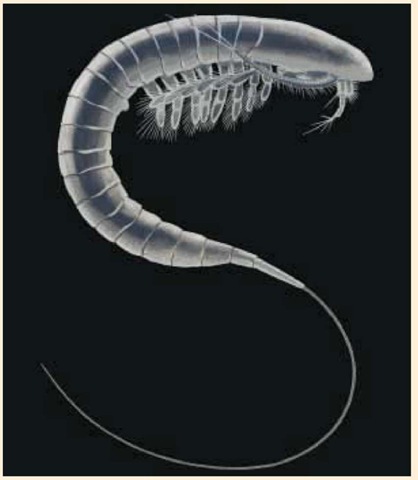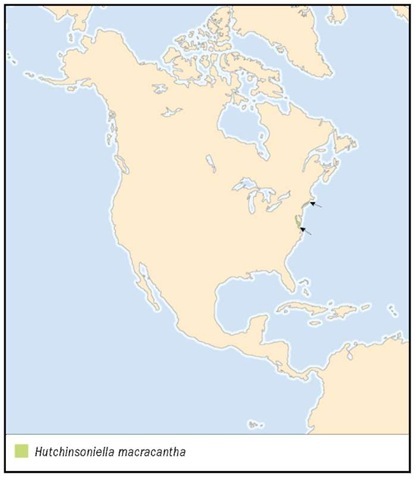Cephalocarida
(Cephalocarids)
Phylum Arthropoda
Subphylum Crustacea
Number of families 2
Thumbnail description
Cephalocarids are small crustaceans with elongate bodies, short heads without carapace, and flattened, paddle-like appendages on the thorax
Illustration: Hutchinsoniella macracantha.

Evolution and systematics
Cephalocarids, when first discovered in Long Island Sound, were thought to be the most primitive of living crustaceans. This view, based on much detailed work on Hutchinsoniella macracantha, stemmed from the fact that cephalocarids possessed limbs that were phyllopodous (that is, flattened and lobe like, with the shape maintained by fluid pressure) and were similar in form from the back of the head to the end of the thorax, and were added sequentially during development. More recently cephalocarids have been recognized as an early group within the Crustacea, but most likely arose after the early line leading to remipedes. The subclass Cephalocarida comprises one extant order, Brachypoda; and two families, Hutchinsoniellidae and Lightiellidae. A total of nine species in four genera are currently known.
Physical characteristics
The cephalocarid head is short and wide, and is covered with a strong dorsal head shield. Ventrally, in front of the mouth, is a large, posteriorly directed labrum, which func-
tions to keep food particles—moving anteriorly as a result of a feeding current set up by the thoracic appendages—from going past the mouth opening. The mouth appendages posterior to the mouth, maxillules, and maxillae are built much like the following limbs of the thorax. That is, they have a basal protopod with endites on the inner margin and epipods and exopods on the outer margin. The endopod has a more or less ambulatory function and consists of 5-6 segments. Metachronal movements of these limbs cause an anteriorly directed feeding current in the mid-ventral groove between the paired appendages. There are 20 post-cephalic somites of which the first eight are considered to belong to the thorax. The abdominal somites do not bear appendages, except for the last somite (telson or anal somite) that has a pair of posteriorly directed uniramous appendages generally referred to as caudal rami.
Distribution
Cephalocarids are found in the upper few millimeters of very fine and often flocculent marine sediments in shallow to deep (5,250 ft [1,600 m]) waters. The nine species are known from east and west United States, Caribbean Islands, Brazil, Peru, southwest Africa, New Caledonia, New Zealand, and Japan.
Habitat
Most cephalocarids have commonly been found in floccu-lent surface muds with high organic content. A few, however, are known from coral rubble and substrates with fine sediment particles.
Behavior
Cephalocarids move through the upper few millimeters of the sediment by moving the thoracic limbs. They do appear to be able to swim or burrow. Occasionally, they will double up the body and use their appendages to groom the abdominal somites.
Feeding ecology and diet
Very small organic particles appear to be the primary food source of cephalocarids. Using the metachronal beat of the thoracic limbs, they pass these small organic particles to the mouth. As the limbs separate, particle-laden fluids are pulled through the interlimb space toward the mid-ventral food groove. As adjacent limbs come together, the fluid is pushed away from the body and particles are retained on the setae of the endites. Turbulence removes particles from the setae and into the food groove. It may be that mucus secreted from glands in the endites helps to bind the particles for ingestion.
Reproductive biology
Mating has not yet been observed, but cross-fertilization is likely since cephalocarids are functional hermaphrodites. Eggs are carried on the reduced appendages of the ninth post-cephalic somite. Young hatch as a metanauplius with three fully developed head appendages (antennules, antennae, and mandibles), two rudimentary appendages (maxillules and maxillae), and three post-cephalic somites without limbs. With each successive molt, the posterior-most appendage changes form from rudimentary to fully developed and the following limb appears in rudimentary form. In addition, at each molt one or two body somites are added until all twenty post-cephalic somites are present.
Conservation status
Very few cephalocarids are found in any abundance; most species so far being known only from one to four specimens. Conservation status is unknown, and no species are listed by the IUCN.
Significance to humans
Cephalocarids are of intellectual interest only, and have no other known significance.
Species accounts
No common name
Hutchinsoniella macracantha
ORDER
Brachypoda
FAMILY
Hutchinsoniellidae
TAXONOMY
Hutchinsoniella macracantha Sanders, 1955, Long Island Sound, United States.
OTHER COMMON NAMES
None known.
PHYSICAL CHARACTERISTICS
Head and thoracic somites wider than those of the abdomen. Eighth thoracic appendage is reduced to a simple lobe and an even smaller appendage is present on the ninth thoracic somite. (Illustration shown in chapter introduction.)
DISTRIBUTION
Virginia, Long Island Sound, and Buzzards Bay, in the United States; northwestern Atlantic Ocean continental slope.
HABITAT
Fine mud with flocculent organic matter.
BEHAVIOR
Lives in the upper few millimeters of the sediment.
FEEDING ECOLOGY AND DIET
Feeds on very fine organic detrital particles.
REPRODUCTIVE BIOLOGY
Developmental sequence consists of 19 molt stages.

CONSERVATION STATUS
Not listed by the IUCN.
SIGNIFICANCE TO HUMANS
None known.
